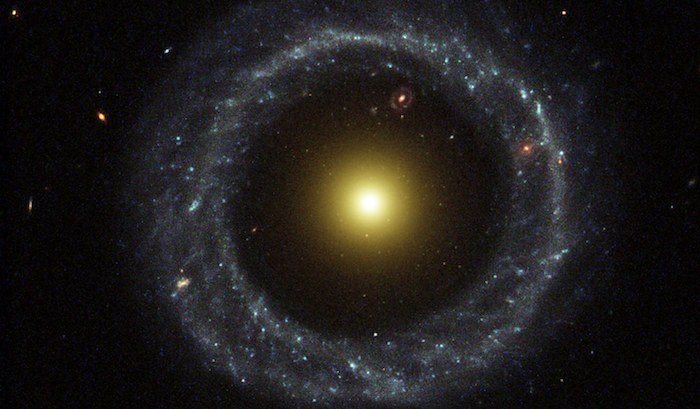Once a month here on the Molten Sulfur Blog, I run content taken from our book Archive: Historical People, Places, and Events for RPGs. This post is one of eighty entries in Archive, each more gameable than the last!
This post is brought to you by beloved Patreon backer Justin Moor. Thanks for helping keep the lights on! If you want to help keep this blog going alongside Justin, head over to the Patreon page – and thank you!

Hoag’s Object
Astronomical Mystery
In 1950, astronomer Arthur Allen Hoag published the first description of an object in space which has come to be named after him. It’s an unusual galaxy with a spheroidal core of older yellow stars surrounded by a nearly perfect ring of young, hot, blue stars. A strange gap separates the ring and the core. Hoag first thought the object resembled a planetary nebula, but was skeptical because the size of the object and the properties of its nucleus were not typical of planetary nebulae. Ever since its discovery, scientists have been trying to learn more about the object.
In 1974, astronomers determined Hoag’s Object lies about 600 million light years away, about 200 times the distance from our galaxy to our nearest neighbor galaxy. They estimated the diameter of the yellow core to be 16,000 light years, similar to the size of the bulge at the center of our galaxy. The gap is about 30,000 light years across. The entirety of Hoag’s Object – ring, gap, and core – is about 120,000 light years in diameter, which makes it almost the same size as our own galaxy. These measurements confirmed that Hoag’s Object is not a planetary nebula, but rather a most peculiar galaxy.
In the mid-1980s, astronomers found evidence of active star formation in the ring of Hoag’s Object. It’s too far away to see individual regions of star formation, but the scientists speculated that the bright blue knots in the ring are likely supermassive clusters of very young stars, shining like spotlights, unlike the calmer yellow flashlights of the older stars in the core. Curiously, the young blue stars are offset. On one side of Hoag’s Object, they’re on the inside edge of the ring, while on the other, they’re towards the outside. The scientists also discovered small quantities of luminous material inside the gap.
Astronomers are still trying to figure out how Hoag’s Object formed. It looks a little like another galaxy collided with Hoag’s Object, leaving a ‘splash’ of stars behind. But no one can find the second galaxy, which casts doubt on the hypothesis. Another proposed explanation is that another galaxy passed near Hoag’s Object, and the Object’s gravity shredded the other galaxy, then collected its material in an orbit that became the outer ring. The ring is smooth, suggesting it’s had two to three billion years to settle down after the initial chaos. But if that’s the case, how are the stars in the outer ring so young? Much about Hoag’s Object remains mysterious.
Hoag’s Object in Play
At your table, uncanny events could point to Hoag’s Object. Perhaps it’s entirely artificial, built to be the eye of a cruel god. Maybe the party uncovers plans to recreate an ancient weapon, a device used only once before: in Hoag’s Object. The collide-and-splash hypothesis is almost true, but instead of being caused by another galaxy over millions or billions of years, it was caused overnight by this appalling device. Alternately, the gap could have been created as a moat to contain something in Hoag’s Object’s galactic core. The locations of the bright young stars encode a warning or a plea for help.
Or maybe the gap was not meant to keep something in, but to keep something out. The civilizations of the core tried to build a firebreak against a ravenous threat on the galactic rim. The gap failed. After gorging itself on the empires of the core, the threat moved on to other galaxies, eventually arriving at ours. Clues to the nature of the threat (and perhaps how to defeat it) can still be found in the gap in Hoag’s Object. Derelict sun-destroying spaceships drift in the void, their computers stuffed with vital data. Dark planets, the remnants of destroyed star systems, whirl through eternal night. Looking up from the surface of any of them, a luminous blue band shines in the black sky. Upon the band is the galactic center – a false sun – set like a diamond on a ring. Frozen cities on these dead worlds may yet have crumbling monuments recounting their last days. But in the frozen void of the gap between ring and core, the threat’s hungry children yet lurk.






